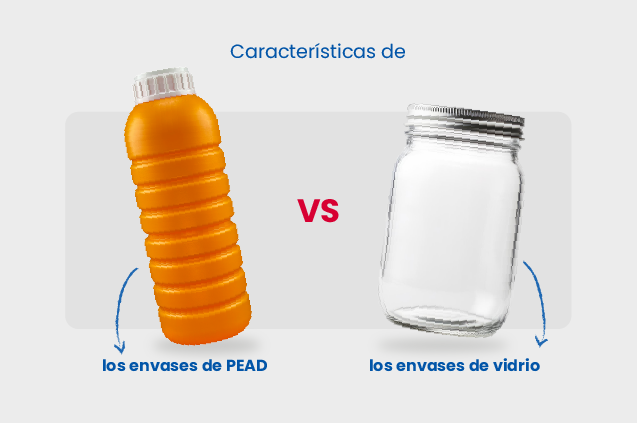There is an ongoing debate about which type of container is better. The truth is, the characteristics of glass containers and High-Density Polyethylene (HDPE) containers are different, each offering specific benefits depending on their intended use.
However, the properties of HDPE containers make them suitable for a wide range of functions. Industries choose this material for its versatility, durability, and, above all, the safety it provides for packaging food, pharmaceuticals, chemicals, agrochemicals, and other liquid products.
Glass containers, on the other hand, do not interfere with the flavor of food and beverages or with the chemical interaction of their contents, but they are fragile.
Characteristics of Glass Containers
Glass containers offer unique benefits and a wide variety of uses. Their characteristics include:
- Transparency: Allows us to see the contents without opening the container, making it useful for product display.
- Recyclability: Glass is recyclable and can be reused multiple times without losing quality.
- Adaptability: Glass has a versatile yet rigid and fragile nature, enabling creative design possibilities.
- Inherence: Protects the qualities of its contents, such as flavor and color. It is impermeable to gases and vapors, ensuring the preservation of food or other stored products.
- Moldability: Can be produced in various shapes and colors, giving it a distinct personality.
- Enhances the consumption experience: Its simplicity as a material can streamline and save time in our activities.
Characteristics of HDPE Containers
HDPE is a type of plastic widely used for containers due to its unique properties. It is non-toxic and more cost-effective to manufacture than other materials. Its characteristics include:
- Rigidity: Known for its high impact and break resistance, making it ideal for handling and transport.
- Safety: Approved for food contact, making it a lightweight option for food and beverages.
- Durability: Has a long lifespan, resists wear during use, and retains its properties even after recycling.
- Chemical Barrier: One of its main features is its non-toxic nature, resistance to moisture and chemicals, and popularity among industries.
- Recyclability: Many HDPE containers can be recycled to create new products.
- Effectiveness: HDPE containers are designed with usability in mind, featuring handles and accessories that simplify product distribution. They are also lighter than glass.
What Sets Them Apart? Which Container Is Better?
After comparing the characteristics of glass and HDPE containers, it’s clear that the choice depends on several factors, such as the type of product, intended use, cost, and environmental considerations.
Glass is made from silica, soda, and lime, while HDPE is a synthetic, flexible plastic that is less fragile and lighter to transport. This latter point reduces transportation costs and facilitates distribution.
While glass is highly resistant to most products, it is also very prone to breaking or cracking. On the other hand, HDPE withstands strong impacts, tolerates high temperatures without deforming, and provides a barrier against moisture and gases.
It’s also important to consider that producing glass consumes more energy than producing HDPE, increasing production costs.
At Plastimex we offer high-quality container solutions for products requiring durability and resistance. Our catalog continues to grow, adapting to your needs Contact us today! Start customizing your containers with us.

